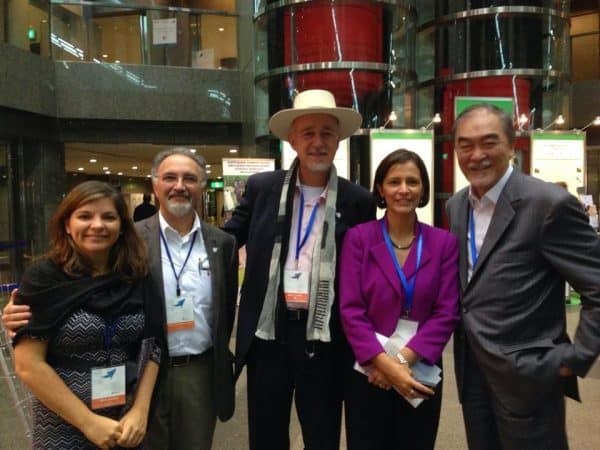
The UNESCO World Conference on Education for Sustainable Development, was held in Nagoya, Japan from 10-12 November. Members of the Earth Charter International Secretariat, Council, Commissioners, and Affiliates participated in this important event.
This Conference celebrated the end of the UN Decade on ESD and the launch of the new Global Action Programme on ESD (GAP), offering a good opportunity to galvanize political support and forge new impetus for this process with a call for renewed commitment.
Around 1,000 people from all over the world participated in the Conference including 76 ministerial-level representatives of UNESCO Member States (mostly from African and Asian countries), NGOs, academia, the private sector, and UN agencies, as well as individual experts and youth participants from 150 countries.
At the Conference, UNESCO presented the Final Report of the Decade. This was preceded by two reports, the first one published in 2009 called ‘Review of Contexts and Structures for ESD’, which focused on contexts and structures for ESD. The second report published in 2012 called ‘Shaping the Education of Tomorrow’, which highlighted the processes and learning for ESD.
The final report launched during this Conference and called “Shaping the future we want: UN Decade oF ESD (2005 – 2014)” shows that progress has been made in raising awareness about ESD, in developing a number of national policies or programmes on ESD, in teacher training, and other efforts, but much more still needs to happen.
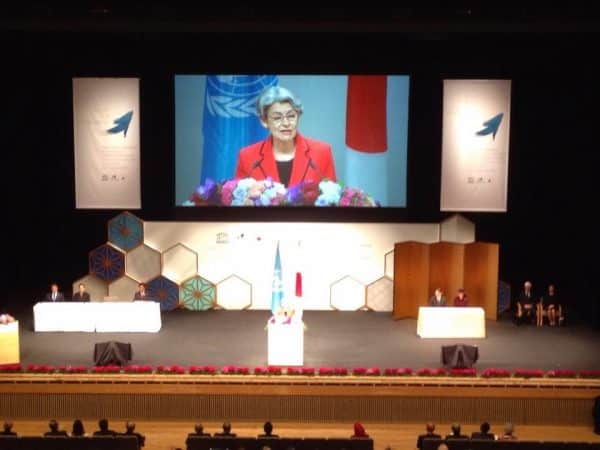
During the opening plenary, Mrs. Irina Bokhova highlighted the progress made on bringing forth the importance of education in sustainable development policies, and in changes in national policies to incorporate sustainable development in national curricula.
UNESCO sees this first ten-year effort as a solid foundation ground for future efforts on ESD, which will also involve strengthening the ESD part of the new Sustainable Development Goals of the UN Post-2015 agenda, which should also strengthen the links between education and sustainable development policies.
The following are specific outcomes of the Conference:
- A political declaration that was drafted and adopted during the closing ceremony. The Aichi-Nagoya Declaration builds on the achievements of the Decade, the Bonn Declaration (2009) and the deliberations of the Conference and the Stakeholder Meetings which were held in Okayama. The Declaration also ensures that the outcomes of the Conference will be taken into account at the World Education Forum 2015 to be held in Incheon, Republic of Korea.
- The Government of Japan announced the creation of an ESD global award.
- A new Global Action Programme on ESD was launched (GAP). The overarching goal of the GAP is “to generate and scale up action in all levels and areas of education and learning to accelerate progress towards sustainable development”. There are five priority action areas of the GAP: a) Advancing policy; b) transforming learning and training environments; c) Building capacities of educators and trainers; d) empowering and mobilizing youth; e) accelerating sustainable solutions at local level.
- GAP Launch Commitments: During the first semester of 2014, UNESCO called all sectors (governmental and non-governmental) to make specific commitments to implement the GAP. These commitments are plans for concrete activities that support one or more of the five Priority Action Areas. As of 12 November there were 360 commitments made (find the information in this map). During the closing ceremony, a commitment for each GAP priority area was presented. UNESCO selected ECI GAP Commitment on Youth to be presented at this plenary. ECI submitted two Commitments: one on teacher training and another one on youth empowerment and training, based on the work ECI has been doing and continues to do.

A number of workshops and side events as well as exhibitions, information booths were organized to offer more spaces for dialogue and sharing of experiences among all participants. In addition, several activities were organized to allow more participation of Japanese people. Earth Charter International organized several activities to share its experiences during the DESD.
Earth Charter activities at WCESD:

On Monday, 10 November ECI held a side event at noon called “Looking back to forge the future: Lessons learned from values-based ESD experiences” In this event, with approximately 60 participants, the ECI Secretariat and Council members presented some of the work done over the past few years to contribute to the Decade and to promote sustainability values in different educational settings.
The experience of the Earth Charter Japan Asia Pacific Committee was presented by Wakako Hironaka and she launched a new booklet put together in Japan called Earth Charter Manga. In addition, insights into the best ways to infuse sustainability values in diverse education environments were discussed. Kartikeya Sarabhai mentioned the importance of sensitivity to the local context, to allow adaptation and interpretation of a principle in a given context. Oscar Motomura shared one lesson that he has learned in his 30 years of experience with training of public and private executives: the importance of facilitating deep dialogue between people from different sectors. The challenge is that this requires time.
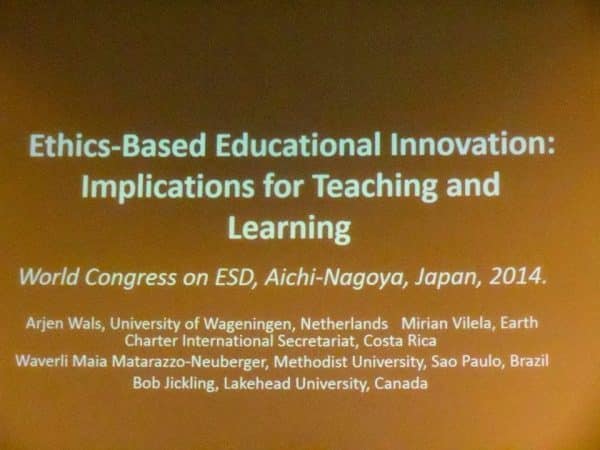
On Monday, 10 November in the afternoon, Mirian Vilela co-organized a workshop called “Ethics-Based Educational Innovation: Implications for Teaching and Learning” with Prof. Arjen Wals of the Wageningen University, The Netherlands. The workshop was well attended (around 150 participants), and the presentations and topic generated good interaction with participants.
This workshop explicitly focused on innovative teaching and learning, particularly the capacity building of educators and trainers, using the Earth Charter for illustrative purposes. Two concrete activities, designed to enhance innovative teaching and learning, were presented. First, Waverly Neuberger presented the case of how the Methodist University of Sao Paulo is reorienting itself towards ESD and using the Earth Charter. She offered many interesting insights and practical suggestions that those working in universities (or even in other type of organizations) can do to make change happen. One idea was to first sensitize and work with colleagues in reconnecting with themselves and nature, as well as having a sense of space and place to be able to see the importance of change with new eyes.
Second, Bob Jickling and Arjen Wals presented an analytical heuristic to assist educators in the evaluation of their own understandings of innovative teaching and learning. In this case the Earth Charter was used to contextualize the analytical tool. There was a rich and vibrant conversation on the role of ethics in formal education in general and the role of ethics in creating meaningful engagement—and action—around ESD. They mentioned that “interest on ethics is on the rise” because for more than 30 years we have known about the dangers of the way we are consuming and producing, but, we are not acting on it. He mentioned that we should avoid making people feel guilty, but make them feel that they can do something positive for other living beings, other humans, and for Planet Earth.
On Tuesday, 11 November in the afternoon, Wakako Hironaka and the Earth Charter Japan Committee organized an event called “ESD and the Earth Charter” mostly for a Japanese audience. Ms. Hironaka opened the event by putting the Earth Charter in a historical context, they launched the Earth Charter Manga booklet they put together, and Mirian Vilela made a presentation about the Earth Charter and some stories of how it’s being used. Presentations were also made by Prof. Tatsuro Kunugi, Prof. Tsuneo Takeuchi, both members of the Earth Charter, Asia-Pacific and Japan Committee, Edo Heinrich-Sanchez, ECI Affiliate from Okinawa, and Dr. Shin-Cheng, Deputy Minister for Environmental Protection of Taiwan. The event attracted about 200 participants.
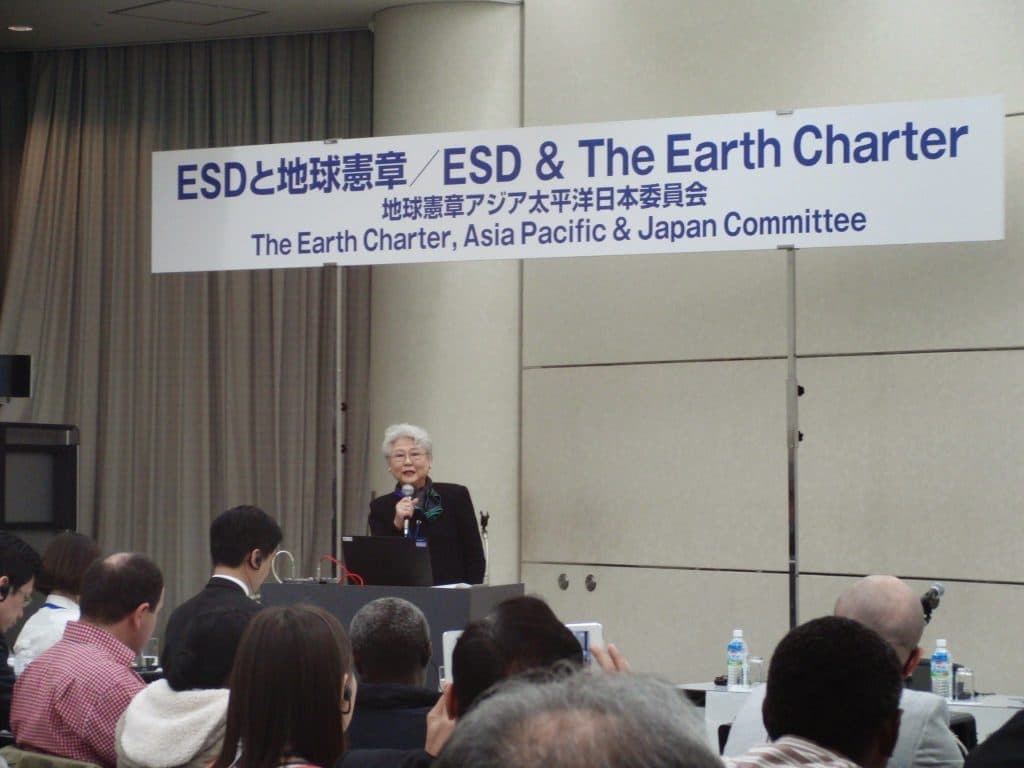
The Earth Charter Education Center was selected as one of the 25 projects identified as best practices on ESD. In this sense, ECI was able to share materials and information on educational experiences at a booth in the Conference lobby, with Conference participants and the general public. This poster was created for the occasion of this Conference and was shown in the booth. It highlights key messages of several educational experiences with the Earth Charter in Latin America. (The reason to include only Latin American experiences is because the EC booth was in this region’s area).
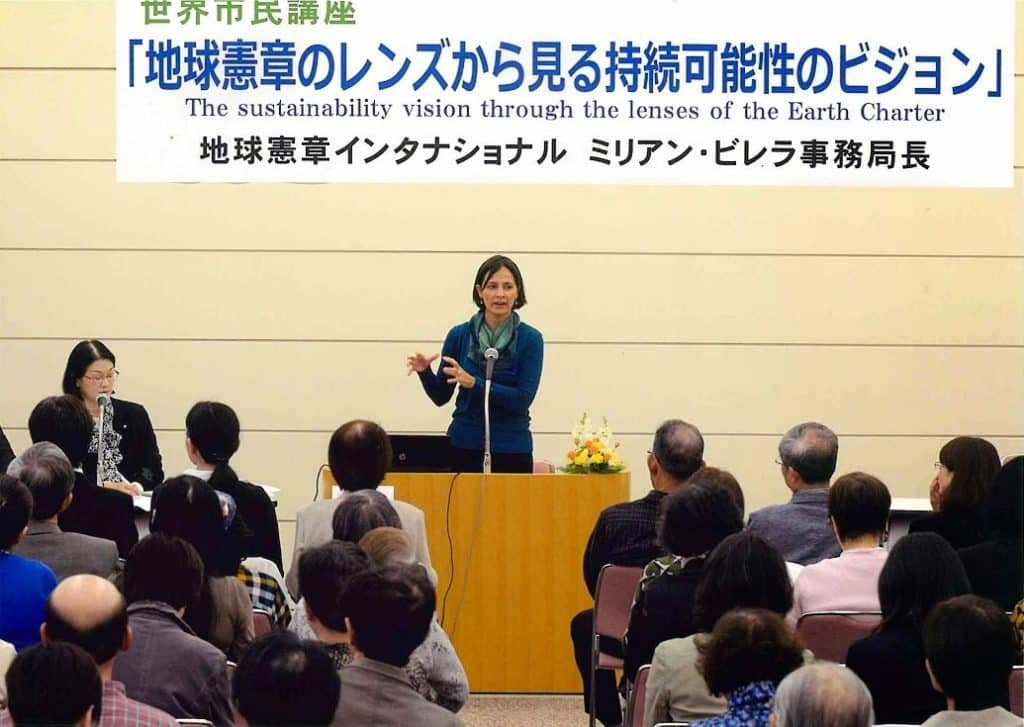
Much of the future work of the Earth Charter Center on Education for Sustainable Development will contribute to the implementation of the GAP objectives which are:
1) “to reorient education and learning so that everyone has the opportunity to acquire the knowledge, skills, values and attitudes that empower them to contribute to sustainable development”.
2) “to strengthen education and learning in all agendas, programmes and activities that promote sustainable development”.
Another contribution that ECI offered to the end of the Decade was a consultation about Latin American’s youth perspective on the Decade of ESD. This consultation was done in collaboration with: Futuro Latinoamericano Foundation in Ecuador, National University of Costa Rica, University of Guanajuato in Mexico, UNEP Regional Office in Panama and UNESCO Regional Office in Chile. Around 400 youth participated in this consultation, through online and face to face workshops.
You can find more information about the UNESCO Conference here.
And here a photo album of the Conference and ECI activities.






